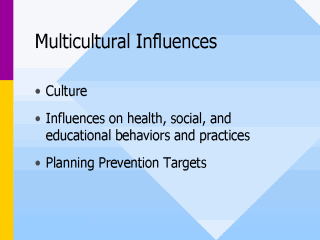| front |1 |2 |3 |4 |5 |6 |7 |8 |9 |10 |11 |12 |13 |14 |15 |16 |17 |18 |19 |20 |review |
 |
Multicultural
Influences A. Culture: The term “culture” refers to the customary beliefs, social forms, and material traits of a race, or religious or social group. It is manifested in family roles and relationships, child-rearing practices, child-disciplinary practices, and expectations of individuals at different stages in the life cycle. It influences methods of teaching and learning, the role of education, work and leisure behaviors, religion, traditions, health beliefs and attitudes, as well as time and space concepts, food preferences, dress and personal appearance, and interpersonal relationships. B. Influences On Health, Social and Educational Behaviors, and Practices: People of all cultural, ethnic, and linguistic backgrounds value good health. However, the ways in which various cultures view, react to, and treat disabilities vary. Cross-cultural beliefs about disabilities will influence individual and family participation in prevention programs. Cultural elements such as language, family roles, gender roles, and religious beliefs can and do influence beliefs about causation of illness, the conditions that qualify as “sickness,” expected treatment outcomes, treatment programs, and how to “prevent” or if “preventive” measures should taken. C. On Planning Prevention Targets: In planning a prevention target, the following are some considerations: 1. Describe the ethnic group with which the family identifies (e.g. language). 2 . Identify the social organization of the ethnic community.3. Describe the prevailing belief system within the ethnic community.4. Learn about the history of the ethnic group and current events that affect the family.5. Determine how members of the community gain access to and use social services. 6. Identify the attitudes of the ethnic community toward seeking help. Transition Point: Based on the communication disorder, various means of prevention can be implemented... |